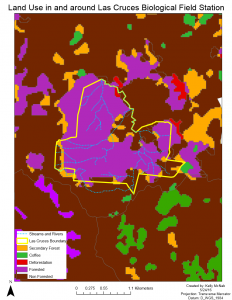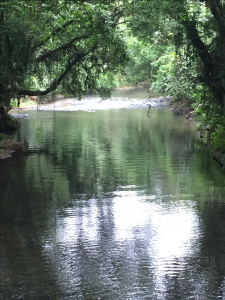Land use change is clearly an issue in Costa Rica. From the moment we arrive at La Selva Biological Field Station, we were introduced to the idea of negative anthropogenic land use through the examples of their agricultural neighbors. Pineapple plantations were the main concern at La Selva because they severely harm the land and most plantations use pesticides in their management practices. This type of negative human land usage has the potential to greatly affect the neighboring rainforest. Because of this, I have decided to do my research project on the impacts of land use on streams using dragonflies and damselflies as a bioindicator of stream health. I am particularly interested in freshwater and marine ecology, so studying streams in the rainforest will be a great opportunity to learn more about these fragile water resources.
Due to their sensitivity to changes in habitat quality and their amphibious life cycle, dragonflies and damselflies are useful for assessing environmental changes. If dragonflies are absent from a water body, there may be potential issues such as pesticides and excessive nutrients from agricultural areas, siltation from bank erosion, or contaminants from human settlements and industry.
I plan to take dragonfly and damselfly abundance measurements on several streams at Las Cruces Biological Field Station. These streams will be selected based on their proximity to certain land use types, including agriculture, deforestation, and natural forested areas. I created a land use map of the area in and surrounding Las Cruces in order to determine the specific types of land use occurring at the site (see image). Overall I expect to see higher dragonfly abundance at areas of low anthropogenic use (such as the natural forested areas) and lower at the areas of agriculture and deforestation.
There is a great need for increased research of the effects of humans on tropical systems, especially aquatic systems. Studies of stream ecology in the tropics are few and far between and this proposed project has the capability of providing valuable information to land managers on the effects of human disturbance on fragile river and stream habitats. As it says in Tropical Nature, “…tropical deforestation progresses at a terrifying rate, variously estimated, but in the vicinity of fifty acres a minute. In most instances, because of the peculiarities of tropical ecology, the land becomes rapidly degraded and worth little to society. At the same time, the major portion of our stock of biological resources— the half or more of all species of animals and plants of the entire planet that reside in these forests— becomes seriously threatened”. So essentially, if we do not monitor and control certain degrading land uses, we run the risk of destroying fragile ecosystems and one of the most productive areas on the earth.

